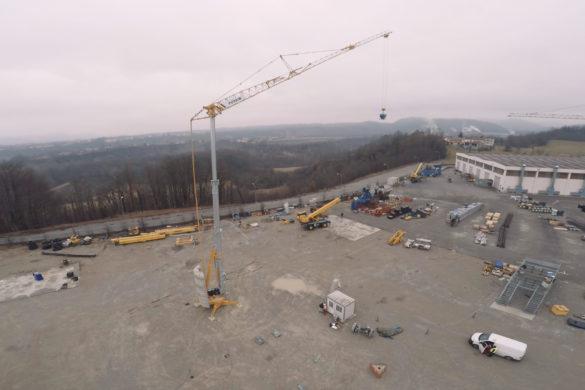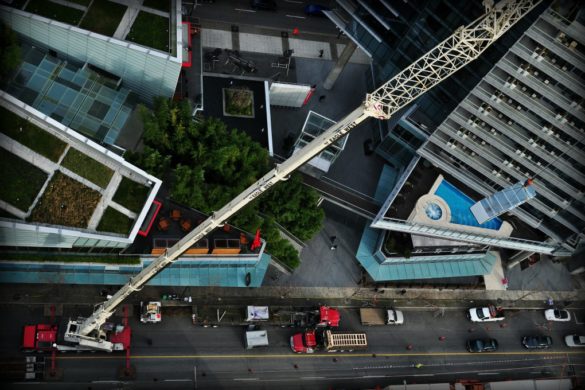 June, 6, 2012—Space Shuttle Discovery, the most traveled shuttle in NASA’s fleet, ended its voyage at Washington Dulles International Airport this spring after more than 150 million miles of airtime. Its final flight took place April 17, 2012, on top of a Boeing 747 Shuttle Aircraft Carrier, where it was slated to replace the Space Shuttle Enterprise at the Smithsonian Institution’s James S. McDonnell Space Hangar at the Steven F. Udvar-Hazy Center. Before being towed from Dulles to its final exhibit place, Discovery had to be hoisted from its carrier and its landing gear lowered into place one final time, which happened with help from a Terex CC2800-1 crawler crane and South Kearny, N.J.-based J.F. Lomma Inc.’s crane and rigging team.
June, 6, 2012—Space Shuttle Discovery, the most traveled shuttle in NASA’s fleet, ended its voyage at Washington Dulles International Airport this spring after more than 150 million miles of airtime. Its final flight took place April 17, 2012, on top of a Boeing 747 Shuttle Aircraft Carrier, where it was slated to replace the Space Shuttle Enterprise at the Smithsonian Institution’s James S. McDonnell Space Hangar at the Steven F. Udvar-Hazy Center. Before being towed from Dulles to its final exhibit place, Discovery had to be hoisted from its carrier and its landing gear lowered into place one final time, which happened with help from a Terex CC2800-1 crawler crane and South Kearny, N.J.-based J.F. Lomma Inc.’s crane and rigging team.
Lomma and the United Space Alliance work crews methodically hoisted the 196,400-pound shuttle off of the 747 Shuttle Aircraft Carrier (SAC). “You cannot describe what it’s like to be part of space shuttle history,” said Frank Signorelli, crane and rigging manager for J. F. Lomma, Inc. Josh Barnett, field service representative for Terex Cranes, who was on site to support Lomma on the lift, added, “It was a one-of-a-kind experience.”
For Lomma, planning for this job started nearly two years ago when company officials first considered bidding for the job. NASA was very specific in what equipment was required for the work. “The bid called specifically for the Terex CC 2800-1 as the primary crane to do the pick as well as all of the other supporting cranes and equipment,” Signorelli said.
Part of the reason for this lies with NASA’s experience with this crane model for a similar pick decades ago. When the 747 SAC transports the space shuttle to a place other than a space center, there is a need for crane and rigging equipment. “These picks do not happen often, since NASA already has a shuttle removal method in place at each space center,” Barnett explained.
In the early 1990s, NASA had the rare need to hoist a shuttle from the 747 SAC, and a Terex legacy brand was selected for the job. “A Demag 2800 crawler crane was used in that project as the primary crane,” mentions Jim Creek, Terex Cranes’ senior product manager for crawler cranes – North America. “NASA has a history of successful lifts with this crane.”
The Terex crane for this job, the CC 2800-1, offers a 660-ton capacity at a 32.8-foot radius, more than enough to handle Discovery’s weight. It features a maximum 196.9-foot main boom length and a variable 100-foot radius Superlift attachment to boost lift capacities. “Superlift offers an additional 4,000 to 600,000 lb (1,814 to 272,155 kg) of counterweight on the tray, which enables the crane to lift more weight further from the crane’s base,” said Creek.
The shuttle project consisted of not one but two shuttle hoists. The first lifted the Space Shuttle Discovery off of the 747 SAC for the shuttle’s eventual spot at the Smithsonian. The second loaded the Space Shuttle Enterprise onto the carrier, so it could be flown to John F. Kennedy International Airport in New York.
It took Lomma nearly three months to prepare for and arrange the pick. “We had conference calls with NASA two times a week,” Signorelli said. “Communication was often and thorough between our company and NASA.”
Lomma purchased the CC 2800-1 two years ago. It was on rent with a customer in Quebec. Upon returning to the yard, the crane was rigged to make sure the right components were in place for the job. “We ran the crane in our yard,” Signorelli said. “The (IC-1) computer screen is extremely user friendly and self-explanatory. It’s not a complicated crane to operate.”
Upon completing the dry run at the yard, Lomma disassembled the crane and sent the components to the jobsite. Lomma’s crews spent three days at Dulles rigging the CC 2800-1 and a fourth day running through test lifts to make sure everything would go smoothly.
When it came time for the shuttle pick, there was very little left to question. “NASA had everything marked out on the ground—positioning for the Terex crane, the supporting crane, and the 747,” explained Signorelli.
The CC 2800-1 crawler crane was equipped with a 177-foot main boom and a 98-foot Superlift mast. Lomma used 352,000 pounds of main counterweight with no central ballasts. Superlift counterweight of 275,000 pounds was added to the tray 50 feet from the crane base. “Normally, a lift like this would require only 220,000 pounds on the Superlift, but NASA’s additional safety factor required an extra 55,000 pounds on the tray,” explained Barnett.
The additional safety requirement stemmed from the need for workers to be under the live load while unhooking the shuttle from its 747 SAC. “NASA required a 75 percent derate from the crane’s standard 85 percentchart, which is a big safety factor,” said Signorelli.
In the overnight hours, when airport activities were at a lull and winds were calm, Lomma and United Space Alliance crews began the removal of the shuttle. The 747 SAC, supporting crane lifting the front of the shuttle, and CC 2800-1 lifting the heavier back end, were all positioned according to NASA’s layout.
NASA engineers used calculations from the CC 2800-1’s IC-1 controls to map out the final position of the crane. “They wanted the connection between the shuttle and our crane to be at 112 feet,” said Barnett, “and the actual distance in the field from the center of the crane to the hook was 111.9 ft (34.1 m). They were impressed with IC-1’s accuracy.”
Author; Unknown
Source:
http://www.cranehotline.com/articles/5866/terex-crawler-lifts-space-shuttle-discovery-into-history/



